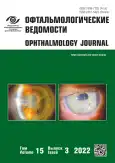The use of platelet lysate to increase the growth-stimulating effect of the amniotic membrane in vitro
- Authors: Bozhenko D.A.1, Chentsova E.V.1, Borovkova N.V.2, Ponomarev I.N.2, Storozheva M.V.2, Makarov M.S.2, Makarov P.V.1
-
Affiliations:
- Helmholtz National Medical Research Center for Eye Diseases
- N.V. Sklifosovsky Research Institute for Emergency Medicine
- Issue: Vol 15, No 3 (2022)
- Pages: 57-62
- Section: Experimental trials
- URL: https://journals.rcsi.science/ov/article/view/131577
- DOI: https://doi.org/10.17816/OV108704
- ID: 131577
Cite item
Abstract
AIM: To work out the technique of saturation of the preserved amniotic membrane (AM) with platelet rich plasma (PRP) lysate and to evaluate the growth-stimulating effect of a combination of AM and PRP lysate in vitro.
MATERIALS AND METHODS: In the experiment, AM samples preserved in 3 ways were used: silicate drying, lyophilization, cryopreservation. PRP lysate was prepared on the basis of volunteers’ blood. During the exposure of AM with PRP lysate, the optimal saturation time of canned AM with lysate was determined, the volume of lysate that 1 cm2 of AM could adsorb was estimated. The growth-stimulating effect of AM transplants was evaluated in the culture of human buccal epithelium. The dynamics of cell growth was evaluated after 1, 2 and 3 days from the moment of sowing.
RESULTS: In the presence of PRP lysate, the mass of silicate–dried AM increased 4.2 times, lyophilized AM — 4.8 times, cryopreserved AM — 1.8 times. AM samples obtained by lyophilization adsorbed PRP lysate most effectively. Five minutes of exposure with PRP lysate are enough to fully saturate the AM. AM without PRP lysate did not give a growth-stimulating effect.
CONCLUSIONS: When comparing experiments with PRP lysate without AM and AM with PRP lysate, it was found that the greatest stimulation of cell growth occurred when using lyophilized AM and PRP lysate. Saturation of cryopreserved AM with PRP lysate was ineffective, and when using silicate-dried AM impregnated with PRP lysate, the greatest growth-stimulating effect was observed on the 1st day.
Full Text
##article.viewOnOriginalSite##About the authors
Dmitry A. Bozhenko
Helmholtz National Medical Research Center for Eye Diseases
Email: panacelium@gmail.com
Postgraduate Student, Ophthalmologist
Russian Federation, MoscowEkaterina V. Chentsova
Helmholtz National Medical Research Center for Eye Diseases
Email: chentsova27@yandex.ru
ORCID iD: 0000-0002-8394-1038
SPIN-code: 8191-8338
Dr. Sci. (Med.), Professor, Head of the traumatology and reconstructive surgery Department
Russian Federation, MoscowNatalia V. Borovkova
N.V. Sklifosovsky Research Institute for Emergency Medicine
Email: borovkovanv@yandex.ru
ORCID iD: 0000-0002-8897-7523
SPIN-code: 9339-2800
Dr. Sci. (Med.), Head of the Biotechnology and Transfusiology Department
Russian Federation, MoscowIvan N. Ponomarev
N.V. Sklifosovsky Research Institute for Emergency Medicine
Email: rzam@yandex.ru
ORCID iD: 0000-0002-2523-6939
SPIN-code: 4705-9314
Cand. Sci. (Med.), Senior Research Associate
Russian Federation, MoscowMaya V. Storozheva
N.V. Sklifosovsky Research Institute for Emergency Medicine
Email: Mayya.storozheva@yandex.ru
ORCID iD: 0000-0003-1927-2404
SPIN-code: 7789-3277
Researcher
Russian Federation, MoscowMaksim S. Makarov
N.V. Sklifosovsky Research Institute for Emergency Medicine
Email: mcsimmc@yandex.ru
SPIN-code: 3543-5800
Cand. Sci. (Med.), Senior Research Associate
Russian Federation, MoscowPavel V. Makarov
Helmholtz National Medical Research Center for Eye Diseases
Author for correspondence.
Email: makarovpavel61@mail.ru
Dr. Sci. (Med.), Leading Research Associate
Russian Federation, MoscowReferences
- Shevlyuk NN, Gatiatullin IZ, Stadnikov AA. Features of reparative histogenesis in bioplastic material application. Journal of Anatomy and Histopathology. 2020;9(1):86–93. (In Russ.) doi: 10.18499/2225-7357-2020-9-1-86-93
- Nejad AR, Hamidieh AA, Amirkhani MA, Sisakht MM. Update review on five top clinical applications of human amniotic membrane in regenerative medicine. Placenta. 2021;103:104–119. doi: 10.1016/j.placenta.2020.10.026.
- Cirman T, Beltram M, Schollmayer P, et al. Amniotic membrane properties and current practice of amniotic membrane use in ophthalmology in Slovenia. Cell and Tissue Banking. 2013;15(2):177–192. doi: 10.1007/s10561-013-9417-6
- Le Q, Deng SX. The application of human amniotic membrane in the surgical management of limbal stem cell deficiency. Ocul Surf. 2019;17(2):221–229. doi: 10.1016/j.jtos.2019.01.003
- McDaniel JS, Wehmeyer JL, Cornell LE, et al. Amniotic membrane allografts maintain key biological properties post SCCO2 and lyophilization processing. J Biomater Appl. 2021;35(6):592–601. doi: 10.1177/0885328220952585
- Walkden A. Amniotic Membrane transplantation in ophthalmology: an updated perspective. Clin Ophthalmol. 2020;14:2057–2072. doi: 10.2147/OPTH.S208008
- Etulain J. Platelets in wound healing and regenerative medicine. Platelets. 2018;29(6):556–568. doi: 10.1080/09537104.2018.1430357
- Borovkova NV, Makarov MS, Ponomarev IN, et al. Experimental study of deep wound regeneration, using biological matrixes with stabilized and non-stabilized platelets. Cell technologies in biology and medicine. 2020;(3):170–177. (In Russ.) doi: 10.47056/1814-3490-2020-3-170-177
- Ponomarev IN, Makarov MS, Borovkova NV, et al. Reparative process in superficial burns treated with wound cover, including collagen bands and platelets (experimental study). Pathological physiology and experimental therapy. 2021;62(2):85–93. (In Russ.) doi: 10.25557/0031-2991.2021.02.85-93
- Golebiewska EM, Poole AW. Secrets of platelet exocytosis — what do we really know about platelet secretion mechanisms? Br J Haematol. 2014;165(2):204–216. doi: 10.1111/bjh.12682
- Borovkova NV, Makarov MS, Andreev YuV, et al. Tamparing of cytokine content in serum and platelet soluble preparations, produced in different ways. Molecular medicine. 2021;19(3):51–57. (In Russ.) doi: 10.29296/24999490-2021-03-08
- Borzenok SA, Rolik OI, Onischenko NA, Komakh YuA. About improvement of corneal graft preservation by using regulatory peptides. Russian Journal of Transplantology and Artificial Organs. 2011;13(4): 101–105. (In Russ.) doi: 10.15825/1995-1191-2011-4-101-105
- Makarov MS, Storozheva MV, Konyushko OI, et al. Effect of concentration of platelet-derived growth factor on proliferative activity of human fibroblasts. Cell technologies in biology and medicine. 2013;(2):111–115. (In Russ.) doi: 10.1007/s10517-013-2199-9
Supplementary files








